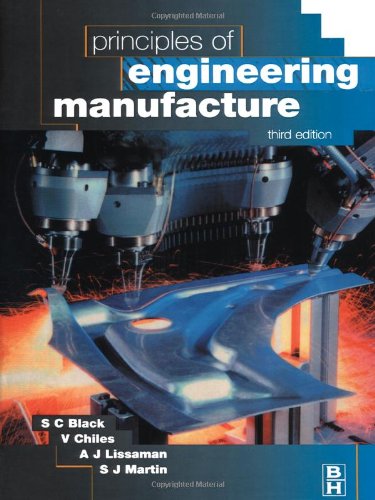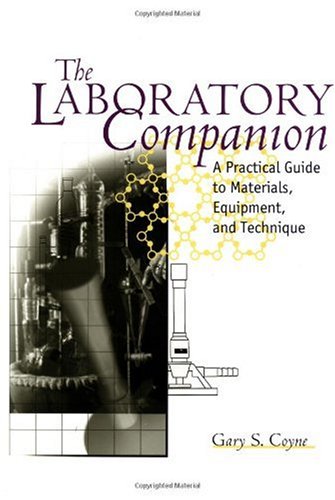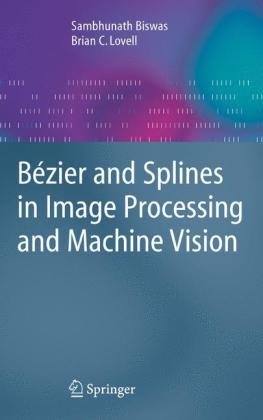V. Chiles, S. Black, A. Lissaman, S. Martin0340631953, 9780340631959, 9780080539614
Table of contents :
Front Cover……Page 1
Principles of Engineering Manufacture……Page 4
Copyright Page……Page 5
Contents……Page 6
Preface to the Third Edition……Page 12
Preface to the Second Edition……Page 14
Extracts from the Preface to the First Edition……Page 16
The Range of Manufacturing Processes……Page 17
1.1 Introduction……Page 18
1.2 Types of production……Page 20
1.3 Manufacturing economics: time and cost estimates……Page 24
1.4 Safety in manufacturing……Page 26
2.1 Introduction……Page 30
2.2 Casting……Page 31
2.3 Moulding……Page 41
2.4 Forging……Page 47
2.5 Continuous extrusion……Page 72
2.6 Rolling……Page 77
2.7 Drawing……Page 79
2.8 Blow moulding……Page 80
2.11 Moulding of reinforced materials……Page 82
3.1 Vacuum forming……Page 85
3.3 Superplastic forming……Page 89
3.5 Shearing……Page 90
3.6 Bending……Page 96
3.7 Drawing……Page 100
3.9 Press load curves……Page 109
3.10 Hydraulic presses……Page 112
3.13 Pipe bending……Page 113
3.14 Spinning……Page 114
3.15 Roll forming……Page 115
4.2 Turning……Page 120
4.3 Moving tool machining……Page 130
5.2 Geometric form of engineering components……Page 145
5.3 Kinematics in machine tools……Page 146
5.4 Kinematics and machining geometric forms……Page 150
5.5 Classification of generating systems……Page 153
6.2 Forces in a machine tool……Page 160
6.3 Structural elements……Page 162
6.4 Slides and slideways……Page 166
6.5 Vibration and chatter……Page 174
6.6 Machine-tool alignments……Page 178
6.7 Straight-line motion……Page 187
6.8 Machine tool spindles……Page 190
6.9 Rolling beatings……Page 195
7.2 Mechanical control……Page 202
7.3 Single spindle bar automatic lathe (SS Auto)……Page 204
7.4 Multi-tooling……Page 205
7.6 Advantages of numerical control……Page 207
7.7 Analysis of the functions of a CNC machine tool……Page 208
7.8 Inputs to the machine control unit……Page 210
7.9 Program preparation……Page 211
7.10 Classification of CNC machine types……Page 213
7.11 Interpolation for contour generation……Page 215
7.12 Displacement of machine tool slides……Page 216
7.13 Manual programming……Page 226
7.14 CAD/CAM links……Page 234
7.15 Machine tool probing systems……Page 236
8.1 Introduction……Page 244
8.2 Chip formation……Page 247
8.3 Machinability……Page 254
8.4 Tool wear……Page 258
9.2 Cutting force analysis……Page 263
9.3 Merchant’s analysis of metal cutting……Page 272
9.4 Merchant’s analysis, work done in cutting……Page 278
10.2 Variables affecting metal-removal rate……Page 284
10.3 Economic cutting speed……Page 291
10.4 Cutting tool materials……Page 296
10.5 Cutting fluids……Page 317
10.6 Other variables influencing the economics of cutting……Page 328
11.1 Introduction……Page 333
11.2 Selection of turning tools……Page 339
11.3 The selection process……Page 341
11.4 Milling……Page 355
11.5 Peripheral milling–geometry of chip formation……Page 369
11.6 Cutting forces and power……Page 378
11.7 Character of the milled surface……Page 387
12.3 Grinding……Page 389
12.4 Creep feed grinding……Page 412
12.8 Barrel finishing (tumbling)……Page 413
12.9 Grit (sand) blasting……Page 414
13.1 Introduction to non-traditional machining……Page 416
13.2 Electro-discharge machining (EDM)……Page 417
13.3 Laser beam machining (LBM)……Page 434
13.4 Ultrasonic machining (USM)……Page 439
13.5 Water jet cutting……Page 443
14.1 Introduction……Page 447
14.2 Nomenclature and specification……Page 452
14.3 Tolerance for ISO metric threads……Page 455
14.4 Screw-thread gauging……Page 459
14.5 Measurement of the effective diameter……Page 464
15.2 Length standards……Page 471
15.3 Some sources of error in linear measurement……Page 478
15.4 Angular measurement……Page 480
15.5 Measurement of small linear displacements……Page 483
15.6 Measurement of small angular displacements……Page 490
15.7 Indirect measurement……Page 492
15.8 Straightness testing……Page 496
15.9 Roundness……Page 498
15.10 Measurement of surface texture……Page 501
15.11 Practical metrology……Page 513
16.2 Interchangeable manufacture……Page 516
16.3 Dimensioning……Page 517
16.4 Tolerances……Page 520
16.5 Economic aspects of tolerancing……Page 526
16.6 Limit gauging……Page 529
16.7 Gauging of tapers……Page 535
16.8 Gauge making materials……Page 540
16.9 Component tolerancing and gauge design……Page 542
16.10 Alternatives to limit gauging……Page 546
16.11 Multi-gauging based on comparators……Page 547
16.12 In-process measurement……Page 548
16.13 Co-ordinate measuring machines……Page 549
17.1 Variability in manufacturing processes……Page 555
17.2 Statistical concepts and variability……Page 556
17.3 Normal curve of distribution……Page 559
17.4 Causes of variation……Page 562
17.5 Relationship between bulk and sample parameters……Page 563
17.6 Control chart for sample average……Page 564
17.7 Control to a specification……Page 567
17.8 Control chart for attributes……Page 572
17.9 Sampling of incoming goods……Page 574
17.10 Tolerance ‘build-up’ in assemblies……Page 582
18.2 Presentation……Page 590
18.4 Transfer……Page 595
18.5 Location……Page 596
18.6 Clamping……Page 601
18.8 Service features……Page 602
19.1 Introduction……Page 604
19.2 Automatic assembly……Page 605
19.3 Factors to consider for automation……Page 606
19.5 Quality……Page 607
19.8 Economic assessment……Page 608
19.9 Automatic assembly techniques……Page 609
19.10 Servicing the assembly line……Page 614
20.1 Introduction……Page 615
20.2 The power press……Page 618
20.3 The lathe……Page 620
20.5 Tool changing……Page 621
20.6 Tool code tagging……Page 625
20.7 Probing……Page 626
20.8 The turning centre……Page 627
20.9 The machining centre……Page 630
20.11 Rapid response manufacturing……Page 632
Bibliography……Page 634
British Standards Specifications……Page 637
Answers to Exercises……Page 640
Index……Page 644







Reviews
There are no reviews yet.